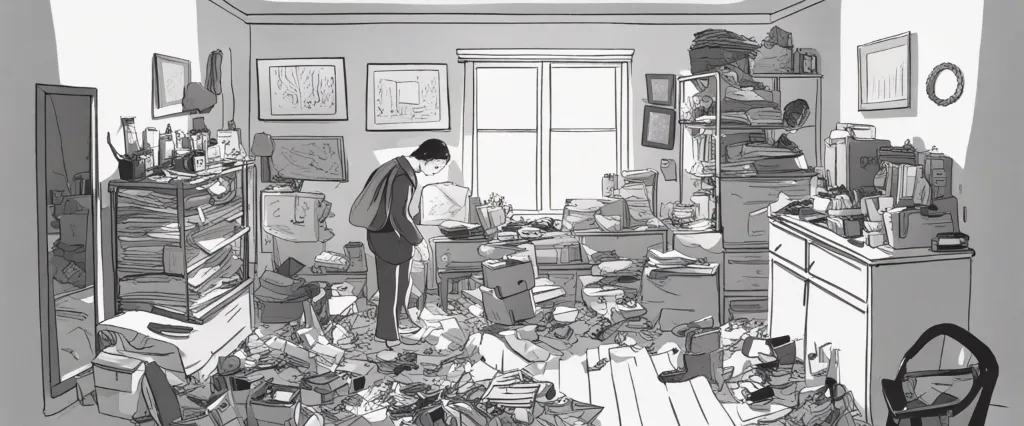In “The Joy of Less” Francine Jay invites readers to explore the liberating world of minimalism, revealing how a simpler lifestyle can bring about ultimate freedom and contentment. Drawing from personal experiences and practical wisdom, Jay shares her profound insights and actionable advice on decluttering, organizing, and embracing a minimalist mindset. As an internationally recognized expert on decluttering and simplifying, Jay has authored numerous bestselling books and has gained a dedicated following through her blog and podcast. Through her thought-provoking writing, she empowers individuals to break free from the confines of consumerism and create harmonious spaces that truly reflect their values and bring lasting joy.
Chapter 1: Embracing Minimalism and Simplifying Your Life
The chapter begins by emphasizing how society encourages consumerism, leading to cluttered homes and overwhelmed lives. Jay proposes that minimalism offers an alternative, allowing individuals to let go of unnecessary belongings and create a more intentional lifestyle.
The author presents the four principles of minimalism: simplify, edit, purge, and organize. Simplifying involves reassessing our true needs and desires, questioning the excess items that fill our homes. To edit means to be conscious of what we bring into our lives, carefully selecting only the things that add value. Purging involves letting go of unused and unnecessary possessions, recognizing that they can be donated or sold to benefit others. Lastly, organizing ensures that the remaining items have dedicated places, leading to an aesthetically pleasing and functional space.
Jay also highlights the benefits of minimalism, both tangible and intangible. Decluttering reduces the time and effort spent on cleaning and searching for items. Additionally, it can alleviate stress and improve mental well-being by creating a more peaceful living environment.
Chapter 1 concludes with practical steps to start embracing minimalism, such as setting clear intentions, creating a plan, and beginning with small, manageable decluttering projects.
Chapter 2: Decluttering Your Physical Space
The chapter begins by emphasizing the importance of purging unnecessary possessions. Jay explains that clutter not only occupies physical space but also overwhelms our minds and hampers productivity. She introduces the concept of the “One-In-One-Out” rule, encouraging readers to let go of an item for every new one they bring into their lives.
Jay provides several decluttering techniques, such as the “Trash Bag Tango” and the “Four-Box Method.” These methods involve sorting belongings into categories like “keep,” “donate/sell,” “recycle,” and “trash.” By systematically evaluating each item, readers can determine what truly adds value to their lives and what can be let go.
The author suggests starting with easy decluttering tasks, such as decluttering one drawer or a small corner. This helps build momentum and motivation to tackle larger areas. Jay also advises readers to minimize duplications, keep sentimental items mindfully, and establish limits on collections to prevent clutter from accumulating again.
Furthermore, the chapter highlights the benefits of donating items to those in need and the positive impacts of recycling and reusing materials to reduce waste. Jay emphasizes the importance of being mindful consumers and avoiding the urge to acquire more stuff to maintain a clutter-free lifestyle.
Chapter 3: Streamlining Your Digital Life
Jay starts by highlighting the negative impact of excessive digital clutter, such as constant notifications, overwhelming email inboxes, and the addictive nature of social media. She emphasizes the need to take control and streamline our digital spaces to regain clarity and focus.
The chapter then provides practical tips for decluttering and organizing digital files. Jay suggests beginning with a comprehensive digital inventory to assess what we have and what can be eliminated. She advises organizing files into logical folders and deleting duplicates and unnecessary documents. By keeping only what is truly important, we free up mental and digital space.
Next, Jay dives into the topic of email management. She advocates for creating a simple and efficient email structure, setting filters and rules to automatically sort incoming messages, and regularly unsubscribing from unnecessary email lists. Jay also emphasizes the importance of limiting checking email to specific times each day for increased productivity and decreased digital overwhelm.
In addition, the chapter explores strategies for decluttering our digital devices, including smartphones and tablets. Jay advises uninstalling unnecessary apps, organizing apps into folders, and reducing the number of digital subscriptions and services we use. By simplifying our devices, we can improve their performance and reduce the distractions they bring.
Chapter 4: Letting Go of Emotional Clutter

Jay explores how personal belongings can carry emotional baggage and hinder our ability to live a simpler, more intentional life.
The chapter begins by emphasizing the importance of understanding the connection between our emotions and our possessions. Jay explains that we often hold on to objects out of fear, sentimentality, or a desire for security. These emotional attachments can lead to clutter and prevent us from experiencing the freedom that comes with letting go.
To address this issue, Jay provides practical strategies for decluttering our emotional baggage. She suggests tackling sentimental items first, encouraging readers to reflect on what truly holds meaning for them and to let go of objects that no longer bring joy or serve a purpose. Jay proposes finding alternative ways to preserve memories, such as taking photographs or creating digital albums.
Furthermore, the chapter delves into the role of fear and guilt in emotional clutter. Jay advises readers to confront their fears and question whether keeping certain items is worth sacrificing their peace of mind and well-being. By carefully examining the reasons behind our attachments, we can recognize that we don’t need physical possessions to maintain our memories or a sense of security.
Ultimately, By shedding emotional attachments to our possessions, we can cultivate a more mindful and minimalist lifestyle, allowing space for meaningful experiences and relationships.
Chapter 5: Cultivating Mindful Consumption and Spending
According to Jay, mindful consumption starts with taking stock of what we already own. She suggests conducting a thorough decluttering session and getting rid of unnecessary possessions. By doing so, we become more aware of the items that truly add value to our lives and those that are mere distractions.
Jay also emphasizes the need to resist the urge of impulsive buying. She encourages readers to question their shopping habits and reflect on whether they truly need the items they are considering purchasing. Jay advises implementing a 30-day waiting period before buying something new, allowing time to evaluate whether the item is truly necessary or simply a passing desire.
Additionally, the chapter emphasizes the importance of quality over quantity. Jay encourages readers to invest in well-made items that will last longer rather than indulging in cheap, disposable goods. By doing so, we save money in the long run and reduce our environmental impact.
Moreover, Jay encourages readers to shift their mindset from a consumer-driven one to a more mindful and experiential one. Instead of finding happiness in possessions, she suggests finding joy in experiences, relationships, and personal growth.
Chapter 6: Designing a Minimalist Home and Environment
The chapter begins by emphasizing the importance of decluttering before considering any design elements. Jay suggests analyzing one’s possessions and only keeping the items that truly bring joy and add value to daily life. This process helps create a clean slate for designing a minimalist space.
The author then introduces the concept of visual clutter and provides tips on how to eliminate it from our homes. By organizing and finding dedicated storage spaces for everyday items, minimizing the number of decorative objects, and employing simplicity in design, a clutter-free environment can be achieved.
Jay also emphasizes the significance of natural light and its impact on a minimalist space. Opening up windows, using light-colored walls, and keeping window coverings minimal or absent altogether help bring brightness and a sense of openness to the space.
In addition, the author addresses the importance of furniture choices in creating a minimalist home. She suggests selecting pieces that are multifunctional, such as a coffee table that doubles as storage or a bed with built-in drawers. This not only saves space but also reduces the need for excess furniture.
Lastly, Jay discusses the importance of maintaining a minimalist mindset while shopping for household items. She advises making intentional purchases, choosing quality over quantity, and considering the long-term value of each item.
Overall, Chapter 6 provides practical advice on creating a minimalist home by decluttering, minimizing visual distractions, utilizing natural light, selecting multifunctional furniture, and adopting mindful shopping habits. By following these principles, readers can design a space that promotes a simpler, more intentional lifestyle.
Chapter 7: Simplifying Your Daily Routine and Habits
The chapter begins by acknowledging that our daily routines can become monotonous and cluttered with unnecessary tasks. Jay urges readers to identify the activities that truly bring joy and purpose, and eliminate the rest. By simplifying our routines, we create more time and energy to focus on what matters most.
Jay then introduces the concept of habit stacking, which involves grouping similar tasks together to create efficient routines. For instance, she suggests combining activities like dishwashing, tidying up, and wiping countertops into a single post-meal routine. By doing so, we avoid repeating similar actions throughout the day, streamlining our time and efforts.
Next, Jay discusses the significance of personal rituals. These are intentional actions and habits that help us create space for self-care and reflection. By incorporating rituals into our daily routines, we can cultivate a sense of calm, mindfulness, and gratitude. Examples of rituals include having a cup of tea in the morning or reflecting on the day before bed.
Furthermore, the chapter touches upon the benefits of establishing a morning and evening routine that align with our priorities and goals. These routines set the tone for the day ahead and help us wind down in the evenings. Jay stresses the importance of starting and ending each day intentionally, incorporating healthy habits and rituals that promote well-being.
Overall, Chapter 7 emphasizes the significance of simplifying our daily routines and habits to create a more meaningful and enjoyable life. By eliminating unnecessary tasks, habit stacking, incorporating rituals, and establishing intentional morning and evening routines, we can streamline our lives, reduce stress, and prioritize what truly matters.

Chapter 8: Finding Joy and Contentment in Less
Jay begins by discussing the concept of scarcity mindset, where individuals constantly strive for more out of fear of not having enough. She encourages readers to shift their perspective towards an abundance mindset, recognizing the abundance already present in their lives and the true value of non-material things like relationships, experiences, and personal growth.
She then introduces the concept of “savoring,” which involves being fully present and appreciating the beauty and momentary pleasures in our lives. By slowing down and embracing simplicity, individuals can find contentment even in the most ordinary moments. Jay advises readers to create intentional spaces in their lives and homes that foster joy, such as creating a cozy reading nook or cultivating a garden.
Furthermore, the chapter delves into the importance of gratitude as a means to find contentment. By practicing gratitude regularly, individuals become more aware of the positive aspects in their lives, leading to a greater sense of fulfillment and happiness.
To conclude, By adopting these practices, individuals can lead more fulfilling and content lives amidst the simplicity of minimalism.
After Reading
In conclusion, Francine Jay’s book “The Joy of Less, A Minimalist Living Guide” provides a practical and insightful approach to embracing minimalism in our lives. Through her personal experiences and step-by-step guidance, Jay encourages readers to declutter their physical and mental spaces, leading to a newfound sense of freedom, contentment, and joy. By adopting the principles of simplicity, mindfulness, and intentional living, Jay shows us how to simplify our possessions, maximize our space, and prioritize what truly matters. This book serves as a valuable resource for anyone seeking to simplify their lives and discover the liberating power of minimalism.
Book Recommendation:
1. So Good They Can’t Ignore You” by Cal Newport:
In this thought-provoking book, Cal Newport challenges the common advice to “follow your passion” and presents a compelling argument for building skills and cultivating a passion for your work instead. Using real-life examples and engaging stories, Newport highlights the importance of deliberate practice, perseverance, and acquiring rare and valuable skills to create a compelling and fulfilling career path.
2. Unlimited Power” by Anthony Robbins:
If you’re seeking a book that empowers you to take control of your life, then “Unlimited Power” is a must-read. Anthony Robbins, a renowned motivational speaker, shares practical strategies and techniques for tapping into your personal power, improving communication skills, creating lasting change, and achieving your goals. Through vivid stories and insightful exercises, Robbins guides readers towards unlocking their full potential and living a life filled with purpose and fulfillment.
3. The Greatest Salesman in the World” by Og Mandino:
In this timeless classic, Og Mandino presents a powerful parable that imparts essential life lessons. Through the story of Hafid, a poor camel boy turned wealthy merchant, Mandino shares ten scrolls containing key principles for success and personal transformation. Each scroll delves into topics such as persistence, love, and the power of positive thinking, making it an inspiring and valuable read for anyone seeking personal and professional growth.
4. Atomic Habits” by James Clear:
For those looking to make meaningful changes in their lives, “Atomic Habits” provides a practical framework for understanding how habits shape our behavior and how to create lasting changes. James Clear emphasizes the power of small, incremental improvements and offers actionable strategies to build and break habits effectively. Backed by scientific research and real-life examples, this book will help you develop a clear roadmap for personal growth and make positive changes stick.
5. Deep Work” by Cal Newport:
Cal Newport once again delivers a thought-provoking book that is crucial in today’s distractible world. “Deep Work” explores the value of focused work and the detrimental effects of constant distractions. Newport provides practical strategies and techniques to cultivate deep work, which is essential for creativity, productivity, and achieving mastery in any domain. Whether you’re a knowledge worker or creative professional, this book will inspire you to rethink your approach to work and reclaim your ability to concentrate deeply on important tasks.
These five books, including “So Good They Can’t Ignore You” by Cal Newport, “Unlimited Power” by Anthony Robbins, “The Greatest Salesman in the World” by Og Mandino, “Atomic Habits” by James Clear, and “Deep Work” by Cal Newport, offer valuable insights and guidance in various aspects of personal and professional growth. Each book tackles important topics, encouraging readers to develop their skills, pursue their passions, build better habits, and find deeper focus in their work.




